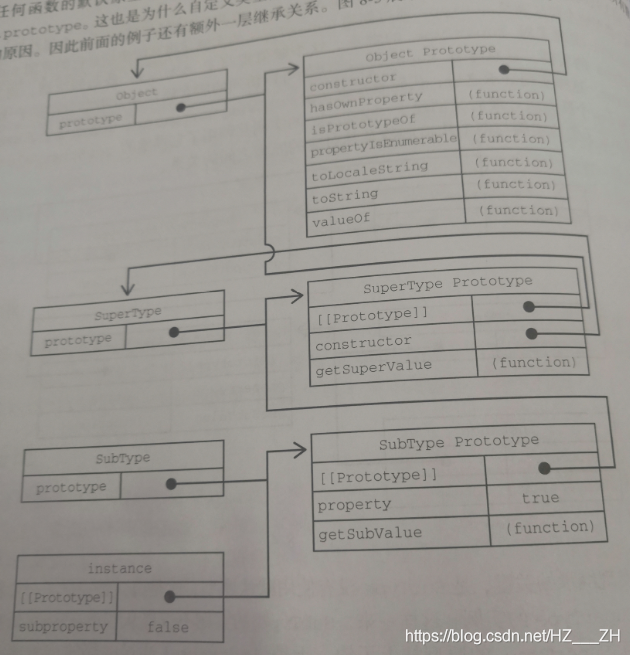简介
class Point {
constructor(x, y) {
this.x = x;
this.y = y;
}
toString() {
return '(' + this.x + ', ' + this.y + ')';
}
}
let p = new point(1,2)
constructor 方法
- constructor()方法是类的默认方法,通过new命令生成对象实例时,自动调用该方法。
class Point {
}
// 等同于
class Point {
constructor() {}
}
//上面代码中,定义了一个空的类Point,JavaScript 引擎会自动为它添加一个空的constructor()方法。
- constructor()方法默认返回实例对象(即this)
class Foo {
constructor() {
return Object.create(null);
}
}
new Foo() instanceof Foo// false
//constructor()函数返回一个全新的对象,结果导致实例对象不是Foo类的实例。
类的实例
- 与 ES5 一样,实例的属性除非显式定义在其本身(即定义在this对象上),否则都是定义在原型上(即定义在class上)。
//定义类
class Point {
constructor(x, y) {
this.x = x;
this.y = y;
}
toString() {
return '(' + this.x + ', ' + this.y + ')';
}
}
var point = new Point(2, 3);
point.toString() // (2, 3)
point.hasOwnProperty('x') // true
point.hasOwnProperty('y') // true
point.hasOwnProperty('toString') // false
point.__proto__.hasOwnProperty('toString') // true
上面代码中,x和y都是实例对象point自身的属性(因为定义在this变量上),所以hasOwnProperty()方法返回true,而toString()是原型对象的属性(因为定义在Point类上),所以hasOwnProperty()方法返回false。这些都与 ES5 的行为保持一致。
- 类的所有实例共享一个原型对象。
var p1 = new Point(2,3);
var p2 = new Point(3,2);
p1.__proto__ === p2.__proto__
//true
__ proto __ 并不是语言本身的特性,这是各大厂商具体实现时添加的私有属性,虽然目前很多现代浏览器的 JS 引擎中都提供了这个私有属性,但依旧不建议在生产中使用该属性,避免对环境产生依赖。生产环境中,我们可以使用 Object.getPrototypeOf 方法来获取实例对象的原型,然后再来为原型添加方法/属性。
注意
- 严格模式
- 不存在提升
new Foo(); // ReferenceError
class Foo {}
- name 属性
class Point {}
Point.name // "Point"
- Generator 方法
class Foo {
constructor(...args) {
this.args = args;
}
* [Symbol.iterator]() {
for (let arg of this.args) {
yield arg;
}
}
}
for (let x of new Foo('hello', 'world')) {
console.log(x);
}
- this 的指向
类的方法内部如果含有this,它默认指向类的实例。但是,必须非常小心,一旦单独使用该方法,很可能报错。
class Logger {
printName(name = 'there') {
this.print(`Hello ${name}`);
}
print(text) {
console.log(text);
}
}
const logger = new Logger();
const { printName } = logger;
printName(); // TypeError: Cannot read property 'print' of undefined
上面代码中,printName方法中的this,默认指向Logger类的实例。但是,如果将这个方法提取出来单独使用,this会指向该方法运行时所在的环境(由于 class 内部是严格模式,所以 this 实际指向的是undefined),从而导致找不到print方法而报错。
解决方法:
- 一个比较简单的解决方法是,在构造方法中绑定this,这样就不会找不到print方法了。
class Logger {
constructor() {
this.printName = this.printName.bind(this);
}
// ...
}
- 使用箭头函数。
静态方法和方法
类相当于实例的原型,所有在类中定义的方法,都会被实例继承。如果在一个方法前,加上static关键字,就表示该方法不会被实例继承,而是直接通过类来调用,这就称为“静态方法”。
class Foo {
static classMethod() {
return 'hello';
}
}
Foo.classMethod() // 'hello'
var foo = new Foo();
foo.classMethod()
// TypeError: foo.classMethod is not a function
静态属性指的是 Class 本身的属性,即Class.propName,而不是定义在实例对象(this)上的属性。
/ 老写法
class Foo {
// ...
}
Foo.prop = 1;
// 新写法
class Foo {
static prop = 1;
}
注意,如果静态方法包含this关键字,这个this指的是类,而不是实例。
class Foo {
static bar() {
this.baz();
}
static baz() {
console.log('hello');
}
baz() {
console.log('world');
}
}
Foo.bar() // hello
父类的静态方法,可以被子类继承。 //注意是子类而不是实例
class Foo {
static classMethod() {
return 'hello';
}
}
class Bar extends Foo {
}
Bar.classMethod() // 'hello'
静态方法也是可以从super对象上调用的。
class Foo {
static classMethod() {
return 'hello';
}
}
class Bar extends Foo {
static classMethod() {
return super.classMethod() + ', too';
}
}
Bar.classMethod() // "hello, too"
实例属性的新写法:实例属性除了定义在constructor()方法里面的this上面,也可以定义在类的最顶层。
class IncreasingCounter {
_count = 0;
get value() {
console.log('Getting the current value!');
return this._count;
}
increment() {
this._count++;
}
}
//上面代码中,实例属性_count与取值函数value()和increment()方法,处于同一个层级。这时,不需要在实例属性前面加上this。
new.target属性
new是从构造函数生成实例对象的命令。ES6 为new命令引入了一个new.target属性,该属性一般用在构造函数之中,返回new命令作用于的那个构造函数。如果构造函数不是通过new命令或Reflect.construct()调用的,new.target会返回undefined,因此这个属性可以用来确定构造函数是怎么调用的。
需要注意的是,子类继承父类时,new.target会返回子类。
class的继承
ES5 的继承,实质是先创造子类的实例对象this,然后再将父类的方法添加到this上面(Parent.apply(this))。ES6 的继承机制完全不同,实质是先将父类实例对象的属性和方法,加到this上面(所以必须先调用super方法),然后再用子类的构造函数修改this。
在子类的构造函数中,只有调用super之后,才可以使用this关键字,否则会报错。这是因为子类实例的构建,基于父类实例,只有super方法才能调用父类实例。
1. Object.getPrototypeOf()
Object.getPrototypeOf方法可以用来从子类上获取父类。
2.super
super这个关键字,既可以当作函数使用,也可以当作对象使用。在这两种情况下,它的用法完全不同。
- 第一种情况,super作为函数调用时,代表父类的构造函数。作为函数时,super()只能用在子类的构造函数之中,用在其他地方就会报错。
//ES6 要求,子类的构造函数必须执行一次super函数。
class A {}
class B extends A {
constructor() {
super();
}
}
注意,super虽然代表了父类A的构造函数,但是返回的是子类B的实例,即super内部的this指的是B的实例,因此super()在这里相当于A.prototype.constructor.call(this)。
class A {
constructor() {
console.log(new.target.name);
}
}
class B extends A {
constructor() {
super();
}
}
new A() // A
new B() // B
上面代码中,new.target指向当前正在执行的函数。可以看到,在super()执行时,它指向的是子类B的构造函数,而不是父类A的构造函数。也就是说,super()内部的this指向的是B。
- super作为对象时
在普通方法中,指向父类的原型对象;在静态方法中,指向父类。
class A {
p() {
return 2;
}
}
class B extends A {
constructor() {
super();
console.log(super.p()); // 2
}
}
let b = new B();
在子类普通方法中通过super调用父类的方法时,方法内部的this指向当前的子类实例。
class A {
constructor() {
this.x = 1;
}
print() {
console.log(this.x);
}
}
class B extends A {
constructor() {
super();
this.x = 2;
}
m() {
super.print();
}
}
let b = new B();
b.m() // 2
- 用在静态方法之中,这时super将指向父类,而不是父类的原型对象。
class Parent {
static myMethod(msg) {
console.log('static', msg);
}
myMethod(msg) {
console.log('instance', msg);
}
}
class Child extends Parent {
static myMethod(msg) {
super.myMethod(msg);
}
myMethod(msg) {
super.myMethod(msg);
}
}
Child.myMethod(1); // static 1
var child = new Child();
child.myMethod(2); // instance 2
//上面代码中,super在静态方法之中指向父类,在普通方法之中指向父类的原型对象。
在子类的静态方法中通过super调用父类的方法时,方法内部的this指向当前的子类,而不是子类的实例。
class A {
constructor() {
this.x = 1;
}
static print() {
console.log(this.x);
}
}
class B extends A {
constructor() {
super();
this.x = 2;
}
static m() {
super.print();
}
}
B.x = 3; //添加B的静态属性
B.m() // 3
//上面代码中,静态方法B.m里面,super.print指向父类的静态方法。这个方法里面的this指向的是B,而不是B的实例。
prototype 属性和_proto_属性
1.子类的__proto__属性,表示构造函数的继承,总是指向父类。
2.子类prototype属性的__proto__属性,表示方法的继承,总是指向父类的prototype属性。
class A {
}
class B extends A {
}
B.__proto__ === A // true
B.prototype.__proto__ === A.prototype // true
这样的结果是因为,类的继承是按照下面的模式实现的。
Object.setPrototypeOf = function (obj, proto) {
obj.__proto__ = proto;
return obj;
}
class A {
}
class B {
}
// B 的实例继承 A 的实例
Object.setPrototypeOf(B.prototype, A.prototype);
// B 继承 A 的静态属性
Object.setPrototypeOf(B, A);
const b = new B();
因此,就得到了上面的结果。
理解
这两条继承链,可以这样理解:作为一个对象,子类(B)的原型(__proto__属性)是父类(A);作为一个构造函数,子类(B)的原型对象(prototype属性)是父类的原型对象(prototype属性)的实例。
https://blog.csdn.net/jiaojsun/article/details/86773523
(最后:望大佬指教class 的prototype 属性和_proto_属性 )
总结:
ES6中怎么实现类的继承的?: es6 的class通过extends关键字实现继承,子类的构造函数必须执行一次super函数。super作为函数调用,代表父类的构造函数,但super内部的this指的是B的实例.(相当于A.prototype.constructor.call(this)。)
ES6的extends被编译后的JavaScript代码
function _possibleConstructorReturn (self, call) {
// ...
return call && (typeof call === 'object' || typeof call === 'function') ? call : self;
}
function _inherits (subClass, superClass) {
// ...
//看到没有
subClass.prototype = Object.create(superClass && superClass.prototype, {
constructor: {
value: subClass,
enumerable: false,
writable: true,
configurable: true
}
});
if (superClass) Object.setPrototypeOf ? Object.setPrototypeOf(subClass, superClass) : subClass.__proto__ = superClass;
}
var Parent = function Parent () {
// 验证是否是 Parent 构造出来的 this
_classCallCheck(this, Parent);
};
var Child = (function (_Parent) {
_inherits(Child, _Parent);
function Child () {
_classCallCheck(this, Child);
return _possibleConstructorReturn(this, (Child.__proto__ || Object.getPrototypeOf(Child)).apply(this, arguments));
}
return Child;
}(Parent));
核心是_inherits函数,可以看到它采用寄生组合继承方式,同时证明了这种方式的成功。不过这里加了一个Object.setPrototypeOf(subClass, superClass),这是用来干啥的呢?
Object.setPrototypeOf = function (obj, proto) {
obj.__proto__ = proto;
return obj;
}
答案是用来继承父类的静态方法。这也是原来的继承方式疏忽掉的地方。
追问:

